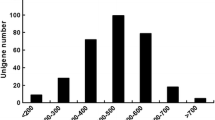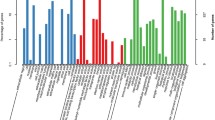Abstract
In insects, biogenic amines have been shown to play an important role in olfactory plasticity. In a first attempt to decipher the underlying molecular mechanisms, we report the molecular cloning and precise expression pattern of a newly identified octopamine/tyramine-receptor-encoding gene in the antennae of the noctuid moth Mamestra brassicae (MbraOAR/TAR). A full-length cDNA has been obtained through homology cloning in combination with rapid amplification of cDNA ends/polymerase chain reaction; the deduced protein exhibits high identities with previously identified octopamine/tyramine receptors in other moths. In situ hybridization within the antennae has revealed that MbraOAR/TAR is expressed at the bases of both pheromone-sensitive and non-sensitive olfactory sensilla and in cells with a neurone-like shape. In accordance with previous physiological studies that have revealed a role of biogenic amines in the electrical activity of the receptor neurones, our results suggest that biogenic amines (either octopamine or tyramine) target olfactory receptor neurones to modulate olfactory coding as early as the antennal level.




Similar content being viewed by others
References
Arakawa S, Gocayne JD, McCombie WR, Urquhart DA, Hall LM, Fraser CM, Venter JC (1990) Cloning, localization, and permanent expression of a Drosophila octopamine receptor. Neuron 4:343–354
Altschul SF, Gish W, Miller W, Myers EW, Lipman DJ (1990) Basic local alignment search tool. J Mol Biol 215:403–410
Blenau W, Balfanz S, Baumann A (2000) Amtyr1: characterization of a gene from honeybee (Apis mellifera) brain encoding a functional tyramine receptor. J Neurochem 74:900–908
Corpet F (1988) Multiple sequence alignment with hierarchical clustering. Nucleic Acids Res 16:10881–10890
Dacks AM, Christensen TA, Agricola H-J, Wollweber L, Hildebrand J (2005) Octopamine-immunoreactive neurons in the brain and subesophageal ganglion of the hawkmoth Manduca sexta. J Comp Neurol 488:255–268
Dacks AM, Joel B, Thomas A, Christensen TA, Nighorn AJ (2006) The cloning of one putative octopamine receptor and two putative serotonin receptors from the tobacco hawkmoth, Manduca sexta. Insect Biochem Mol Biol 36:741–747
Dolzer J, Krannich S, Fischer K, Stengl M (2001) Oscillation of the transepithelial potential of moth olfactory sensilla are influenced by octopamine and serotonine. J Exp Biol 204:2781–2794
Ebert PR, Rowland JE, Toma DP (1998) Isolation of seven unique biogenic amine receptor clones from the honey bee by library scanning. Insect Mol Biol 7:151–162
Evans PD (1985) Octopamine. In: Kerkurt GA, Gilbert L (eds) Comprehensive insect physiology, biochemistry and pharmacology. Pergamon, Oxford, pp 499–530
Evans PD, Maqueira B (2005) Insect octopamine receptors: a new classification scheme based on studies of cloned Drosophila G-protein coupled receptors. Invert Neurosci 5:111–118
Grosmaître X, Marion-Poll F, Renou M (2001) Biogenic amines modulate olfactory receptor neuron firing activity in Mamestra brassicae. Chem Senses 26:653–661
Hammer M, Menzel R (1998) Multiple sites of associative odor learning as revealed by local brain microinjections of octopamine in honeybees. Learn Mem 5:146–56
Jacquin-Joly E, Bohbot J, François MC, Cain AH, Nagnan-Le Meillour P (2000) Characterization of the general odorant–binding protein 2 in the molecular coding of odorants in Mamestra brassicae. Eur J Biochem 267:6708–6714
Jorgensen K, Almaas TJ, Marion-Poll F, Mustaparta H (2007) Electrophysiological characterization of responses from gustatory receptor neurons of sensilla chaetica in the moth Heliothis virescens. Chem Senses 32:863–879
Kutsukake M, Komatsu A, Yamamoto D, Ishiwa-Chigusa S (2000) A tyramine receptor gene mutation causes a defective olfactory behavior in Drosophila melanogaster. Gene 245:31–42
Lange AB (2008) Tyramine: from octopamine precursor to neuroactive chemical in insects. Gen Comp Endocrinol (in press)
Linn CE, Roelofs WL (1986) Modulatory effects of octopamine and serotonin on male sensitivity and periodicity of response to sex pheromone in the cabbage looper moth Trichoplusia ni. Arch Insect Biochem Physiol 3:161–172
Linn CE, Campbell MG, Roelofs WL (1992) Photoperiod cues and the modulatory action of octopamine and 5-hydroxytryptamine on locomotor and pheromone response in male gypsy moths, Lymantria dispar. Arch Insect Biochem Physiol 20:265–283
Linn CE, Poole KR, Roelofs WL (1994a) Studies on biogenic amines and their metabolites in nervous tissue and hemolymph of adult male cabbage looper moth. I. Quantitation of photoperiod changes. Comp Biochem Physiol 108C:73–75
Linn CE, Campbell MG, Poole KR, Roelofs WL (1994b) Studies on biogenic amines and their metabolites in nervous tissue and hemolymph of adult male cabbage looper moth. II. Photoperiod changes relative to random activity and pheromone-response thresholds. Comp Biochem Physiol 108:87–98
Maïbèche-Coisné M, Merlin C, François MC, Queguiner I, Porcheron P, Jacquin-Joly E (2004) Putative odorant-degrading esterase cDNA from the moth Mamestra brassicae: cloning and expression patterns in male and female antennae. Chem Senses 29:381–390
Nisimura T, Seto A, Nakamura K, Miyama M, Nagao T, Tamotsu S, Yamaoka R, Mamiko O (2005) Experiential effects of appetitive and nonappetitive odors on feeding behavior in the blowfly, Phormia regina: a putative role for tyramine in appetite regulation. J Neurosci 25:7507–7516
Ohta H, Utsumi T, Ozoe Y (2003) B96Bom encodes a Bombyx mori tyramine receptor negatively coupled to adenylate cyclase. Insect Mol Biol 12:217–223
Ohta H, Utsumi T, Ozoe Y (2004) Amino acid residues involved in interaction with tyramine in the Bombyx mori tyramine receptor. Insect Mol Biol 13:531–538
Ohtani A, Arai Y, Ozoe F, Ohta H, Narusuye K, Huang J, Enomoto K, Kataoka H, Hirota A, Ozoe Y (2006) Molecular cloning and heterologous expression of an alpha-adrenergic-like octopamine receptor from the silkworm Bombyx mori. Insect Mol Biol 15:763–72
Pophof B (2000) Octopamine modulates the sensitivity of silkmoth pheromone receptor neurons. J Comp Physiol [A] 186:307–313
Pophof B (2002) Octopamine enhances moth olfactory responses to pheromones, but not those to general odorants. J Comp Physiol [A] 188:659–662
Renou M, Lucas P (1994) Sex pheromone reception in Mamestra brassicae: responses of olfactory receptor neurons to minor components of the pheromone blend. J Insect Physiol 40:75–85
Roeder T (1999) Octopamine in invertebrates. Prog Neurobiol 59:1–31
Roeder T (2005) Tyramine and octopamine: ruling behavior and metabolism. Annu Rev Entomol 50:447–477
Saudou F, Amlaiky N, Plassat JL, Borrelli E, Hen R (1990) Cloning and characterization of a Drosophila tyramine receptor. EMBO J 9:3611–3617
Scheiner R, Plückhahn S, Öney B, Blenau W, Erber J (2002) Behavioural pharmacology of octopamine, tyramine and dopamine in honey bees. Behav Brain Res 136:545–553
Sunghoon L, Byungwook L, Insoo J, Sangsoo K, Jong B (2006) Localizome: a server for identifying transmembrane topologies and TM helices of eukaryotic proteins utilizing domain information. Nucleic Acids Res 34 (Web Server Issue):W99–W103
Tamura K, Dudley J, Nei M, Kumar S (2007) MEGA4: Molecular Evolutionary Genetics Analysis (MEGA) software version 4.0. Mol Biol Evol 24:1596–1599
Von Nickisch-Rosenegk E, Krieger J, Kubick S, Laage R, Strobel J, Strotmann J, Breer H (1996) Cloning of biogenic amine receptors from moths (Bombyx mori and Heliothis virescens). Insect Biochem Mol Biol 26:817–827
Acknowledgments
The authors thank Sylvia Anton and Philippe Lucas (UMR PISC, INRA Versailles, France) for valuable discussions and support.
Author information
Authors and Affiliations
Corresponding author
Additional information
This work was supported by INRA, Université Paris VI, ACI JC5249 funding and by an ACI JC doctoral fellowship to Isabelle Brigaud.
Dr. Isabelle Brigaud and Dr. Xavier Grosmaître has contributed equally to the work.
Rights and permissions
About this article
Cite this article
Brigaud, I., Grosmaître, X., François, MC. et al. Cloning and expression pattern of a putative octopamine/tyramine receptor in antennae of the noctuid moth Mamestra brassicae . Cell Tissue Res 335, 455–463 (2009). https://doi.org/10.1007/s00441-008-0722-5
Received:
Accepted:
Published:
Issue Date:
DOI: https://doi.org/10.1007/s00441-008-0722-5




